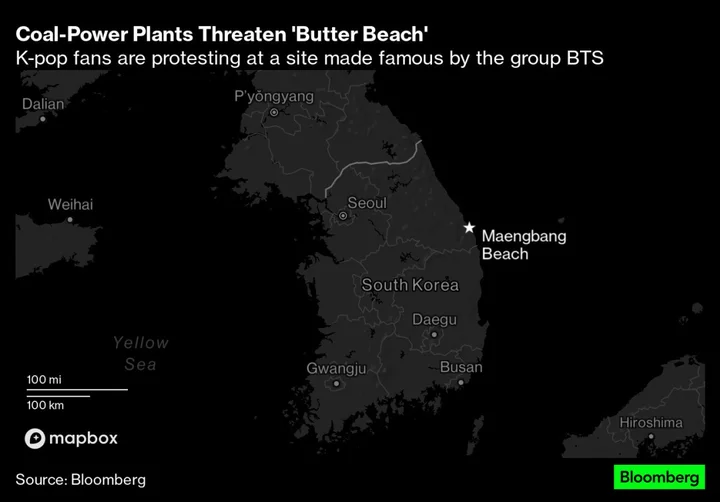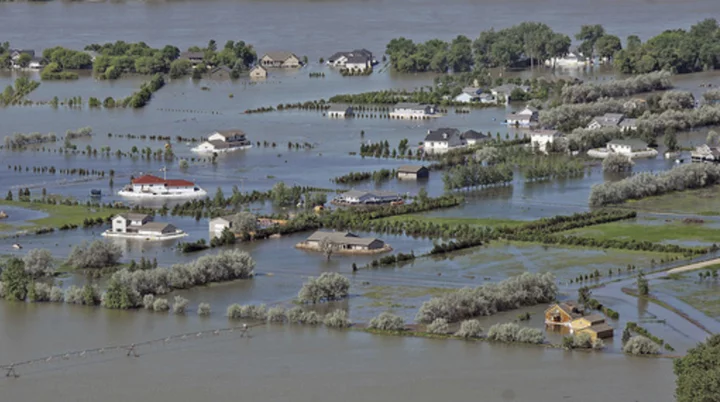As heavy rains pummeled South Korea last month, K-pop fans braved stormy conditions to stage a protest on an east coast beach that's become synonymous with the genre and is now a flashpoint for concerns over the environmental impact of the country’s unwavering coal addiction.
The long stretch of soft, silver sand at Maengbang was the site of a famous photo shoot for the sleeve of BTS’s 2021 hit song Butter and is now a pilgrimage site for the band's devotees. Just six miles away, a gigantic coal-burning power plant is under construction and could be fired up as soon as October. Dotted along the shoreline are dredgers completing work to add artificial sand, groynes, jetties and breakwaters to prevent further coastal erosion.
“K-pop fans are sincerely concerned, not only because our precious spot is getting destroyed,” said Lee Da-yeon, a 20-year-old English literature student who was part of the recent protest. “When we come together as a global legion of K-pop fans, we believe we have the power and influence to tackle the most devastating issue of our time — climate change.”
Protest group Kpop4planet launched the “Save the Butter Beach” campaign in 2021 with nonprofit Korea Beyond Coal, aiming to harness the immense influence that K-pop enthusiasts have been known to wield online. While the demonstrations are unlikely to halt the new coal-fired plant in Samcheok, Gangwon province, the fans' advocacy is highlighting concerns over President Yoon Suk Yeol's approach to climate change.
Yoon has backtracked on the scale of solar and wind energy deployments, even as companies like Samsung Electronics Co. and their investors urge a swifter switch to cleaner power. His government favors the expansion of nuclear plants and the use of carbon offsets or technologies that can help sustain the consumption of fossil fuels.
Coal is expected to account for about 20% of South Korea's power generation by the end of the decade, retaining a crucial role in the nation's energy mix even as that share falls from about a third in 2021.
In fact, a total of 7.3 gigawatts of coal-fired power capacity will be added in South Korea between 2020 and 2025, and only 3.6 gigawatts removed, according to government data compiled by Bloomberg. Gangwon alone will be home to about a fifth of that capacity by the end of next year, the data show.
The global use of coal for power generation increased in 2022 as Russia's war in Ukraine upended supply chains for natural gas and as electricity demand continues to rise in key developing economies. While the fuel's share of the world’s power mix is forecast to decline as nations strive to hit net zero, opponents worry that any addition of new coal plants risks locking in the use of highly polluting power sources for decades more.
South Korea's previous government pledged to cut emissions 40% below 2018 levels by 2030, a policy already criticized as underwhelming by Climate Action Tracker, a research project led by nonprofit groups. Since taking office last year, Yoon has also diluted some key targets, like giving major corporate polluters an easier path to curb emissions and scaling down ambitions for renewable energy to account for 22% of power generation by 2030 from 30% previously.
The coal plant near Butter Beach is expected to release more than 13 million tons of greenhouse gas emissions every year, according to climate activists. And at a cost of 4.9 trillion won ($3.8 billion), Korea could have added 2.9 gigawatts of solar power, or 1.8 gigawatts of onshore wind, with that money, according to calculations by BloombergNEF.
“I’m utterly at a loss for words, looking at where Korea’s energy transition is headed,” said Hong Jong-ho, a professor at Seoul National University Graduate School of Environment Studies.
South Korea’s energy ministry declined to comment on the country’s use of coal. Developer Samcheok Blue Power Co. did not respond to requests for comment. In a March prospectus the company said its coal plant will be equipped with "the highest level of environmental facilities in Korea to minimize pollutant emissions," and insisted the operation is required to provide energy security and help stabilize electricity prices.
The Samcheok operation will have a total capacity of 2.1 gigawatts, making it the country's seventh-biggest coal-fired plant.
Partnering with K-pop fans has already proven to be effective in augmenting its anti-coal message, said Korea Beyond Coal.
“Having the K-pop fans on board took the campaign to the next level because they belong to one of the biggest, most organized and fastest groups on the internet,” said Bae Yeojin, a campaigner at the organization. “This was really the first time ever since we’ve attracted any global attention to a local matter.” A joint 2021 petition by the group and Kpop4planet garnered about 50,000 signatures, which Bae said was “incredibly high” for a local climate campaign.
Even before the plant starts burning coal, there’s already an impact for residents of the town. Samcheok Blue Power began transporting coal by trucks in July to test the complex while it waits for the completion of a port. Almost 890,000 tons of coal will be required over the next eight months, according to the company.
“We'd be seeing one coal-loaded truck approximately every minute driving in and out of our town,” said Ma Kyungman, a 61-year-old strawberry farmer in Samcheok who has taken part in local demonstrations against the coal plant and nuclear energy. “I can’t just sit and watch coal becoming a silent killer to my family and my beautiful hometown.”
He said his focus will now be to try keep the new plant’s run rate low and to have it closed as soon as possible.
The disruption to Samcheok also threatens to undermine the BTS-inspired tourism that's boosted trade for hotels, cafes and restaurants. Already the arrival of equipment to manage coastal erosion and construction of a new port has changed the once idyllic view at Maengbang, including from the exact spot where the band was photographed on a row of striped sun loungers.
“I drove three hours to be here, and I am super disappointed,” said Kim Hwal-ran, a 42-year-old BTS fan who brought her children to the beach. “It’s hard to believe this was the spot where the photo shoot took place.”









